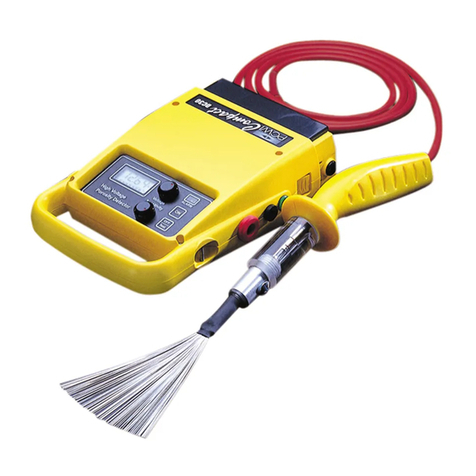
23
Coating Thickness Range
Appliedcoatsshould becured, thicknesstested,visuallyinspected
and accepted – before high voltage porosity testing is carried out.
Coating thickness should be above 150µm; coatings below this
thicknessshouldbetestedwithawetspongeunit.
2.0 OPERATION
Connect the probe and earth leads to the unit. Connect the earth
clamp to the metallic substrate of the item to be tested –
substrate should be earthed to ground. Select the probe best
suited for the test and attach to the probe handle.
Fit the Fuse (if not already fitted).
Turn the unit on.
Test the batteries to ensure that they are charged.
Adjust the voltage control to the required test voltage.
Place the probe near the metal substrate.
A spark should occur (if not re-check all leads and connections).
The unit should now be ready for use.
Re-check the output – adjust if necessary.
Place the probe on the coated surface and move at
approximately one metre per four seconds.
A fault is indicated by:
A spark at the probe – this can usually be seen and heard.
A light flashes on the front panel of the unit.
An audible sound – buzzer is mounted inside the unit.
Note:A definite flaw should be made in the coating and located with the
designated test voltage, therefore proving that the unit is locating the
typeoffaultyouwishtofind.
Probesmustbekeptinfullcontactwiththesurface,gapsinorbetween
theprobeandthecoatingmayresultinflawsgoingundetected.
Wire brushes, rubber and coil spring probes should all be kept in good
condition.
Probesotherthanfinewirebrushesmayrequirehighervoltages.
1.0 SAFETY PRECAUTIONS:
All hand-held high voltage test equipment should be operated
byresponsible,trainedandauthorisedpersonnel.
The unit must be earthed to both the item under test and to
ground.
CAUTION
The Detector output can be up to 65,000 volts. Should the
operatoraccidentallymakecontactwiththe testelectrode,they
may experience a mild shock or zap, and in order to avoid this
possibility,thewearingofrubberglovesisrecommended.
Furthermore, the operator should enjoy good health and not
suffer from a cardiac condition. If the operator has a
pacemaker,thentheyshouldnotusethisequipment.
Thisequipment shouldonly beusedfor thepurposeforwhich it
was designed, ie: checking the porosity, or electrical
breakdown,ofdielectricorinsulatingmaterials.
It is also recommended that testing should be carried out well
clear of personnel not involved in the testing procedure, or in
such a position whereby the surprise of receiving an electric
shock could cause a related accident, if for example, tests
being carried out close to moving or rotating machinery, or in
such an unstable position that the operator could fall and injure
themselves.
It is recommended that the operator should have an assistant,
toensure thatunauthorisedpersonnel arekeptwell clearofthe
testing area, and generally assist when necessary with the
testingprocedure.It isalsorecommendedthattheDetectornot
be operated within close proximity of sensitive electronic
apparatus,suchascomputerequipment.
DANGER
Donot usethetest equipment inany combustible orflammable
atmosphere, as a test voltage can cause an arc or spark to be
generatedandanexplosioncouldresult.
Always consult the plant or safety officer before carrying out a
testprocedure.
When testing tank internals, be certain the tank does not
containsolventsremainingfromthepaintingprocedure.































